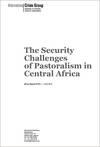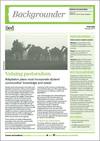Vulnerability and poverty levels remain stubbornly high and arguably are deepening in many pastoral areas of the Horn of Africa. This is in spite of galloping livestock commercialisation
in these areas and their closer incorporation into wider systems of marketing, trade and
investment. The fact remains that the benefits of recent growth and investment in pastoral areas have yet to result in wider benefits for addressing food insecurity and poor nutrition. Thus, strengthening social protection systems in the region is a prerequisite for realising more inclusive growth at the pastoral margins.
This brief details the role of social protection in agendas to promote agricultural growth, highlighting areas of innovative programme design and implementation where further efforts might focus.
Year of publication: 2014Organization:
Topic: Économie, Sécurité alimentaire, Jeunesse et égalité des sexes, Peuples autochtones, Services sociaux
Language: English
Type of document: Technique
Geographical coverage: Afrique orientale
After decades of comparative neglect, the drylands of the Horn of Africa are experiencing an unprecedented surge of investment. But uneven investment can be a barrier to formal private sector engagement; and leave pastoralists more vulnerable to shocks and ill-equipped to take advantage of processes of economic transformation.
Therefore, this publication provides recommendations for investing in drylands for the greater public good. The recommendations are made with a view to ensuring that investment in drylands reinforces poverty reduction and food security.
Year of publication: 2014Organization:
Topic: Économie, Finance, Sécurité alimentaire, Régime foncier, Services sociaux, Value addition
Language: English
Type of document: Technique
Geographical coverage: Afrique orientale
Although Ethiopia has seen dramatic increases in formal exports, it is less recognised that pastoralist areas supply most of the animals for export. For this supply to be maintained or increased, specific livestock policy support is needed based on consultation with pastoralists, traders and other private sector actors, along with stronger coordination of the government ministries that oversee different aspects of the production and trade system.
This policy brief presents a brief overview of the eco-political landscape of livestock trade, lessons learnt from livestock and trade programmes, and policy priorities for supporting pastoral livestock marketing.
Year of publication: 2014
Organization:
Topic: Économie, Peuples autochtones, Participation, Value addition
Language: English
Type of document: Technique
Geographical coverage: Afrique orientale
Into the fold: What pastoral responses to crisis tell us about the future of pastoralism in the Horn
More than ever before, pastoral areas of the Horn of Africa are coming into the fold of wider economic processes. Expropriations of land and key resources in rangelands for the establishment of private ranches and commercial farms, the expansion of roads, telecommunications, and marketing facilities to promote trade and mobility, and investments in hydrocarbons are some of the ways that pastoral areas are being newly encapsulated into regional and global capitalist development.
This paper is concerned with how pastoral livelihoods are likely to evolve in areas of the Horn of Africa where processes of incorporation are intensifying. It reports the findings of a survey of 110 Maasai households in seven sites in Laikipia on pastoral livelihoods and strategies to manage and recover from the severe drought crisis of 2008-2010.
Year of publication: 2014Organization:
Topic: Changement climatique, Économie, Sécurité alimentaire, Peuples autochtones, Régime foncier, Résilience, Services sociaux, Value addition
Language: English
Type of document: Technique
Geographical coverage: Afrique orientale
In the last few years, conflicts between pastoralists and local communities have intensified because of a combination of factors: worsening security; climate change; the multiplication of migration roads, especially transnational routes; the expansion of cultivated areas and an increase in cattle herds. The report looks at three countries – Chad, Central African Republic and Democratic Republic of Congo – and explores various approaches of managing pastoral conflict and regulate transhumance.
Year of publication: 2014Organization:
Topic: Conflit
Language: English, Français
Type of document: Technique
Geographical coverage: Afrique centrale
More than just a means of production, pastoralism is a way of life intrinsically linked to the identity of the individuals and communities that practise it. Given their traditionally nomadic lifestyle, the fact that pastoralists can become internally displaced is often overlooked. Some even question whether it can happen at all.
This study focuses on northern Kenya. It argues that their internal displacement is a reality that has to be understood within a broader discourse about mobility, and creates a conceptual understanding of the phenomenon by examining its multi-causality. In doing so, it also discusses processes and options for improving protection and assistance for those affected. Pastoralists’ internal displacement is presented as a process of impoverishment and decreasing resilience, which leads to the disenfranchisement of rights, marginalisation and neglect. As such, it is as much a human rights as a humanitarian and development concern that requires a holistic approach.
Year of publication: 2014Organization:
Topic: Changement climatique, Conflit, Régime foncier, Résilience
Language: English
Type of document: Technique
Geographical coverage: Afrique orientale
This two-page document summarizes IIED’s position and work on pastoralism. Policymakers have ignored the wealth of experience and expertise of pastoralists with negative consequences. In the face of climate change and increasing uncertainty in drylands, the need to reframe policy and practice has never been greater. The future must be built on sound scientific information, local knowledge, informed participation and the wisdom of local institutions.
Year of publication: 2014Organization: Institut international pour l'environnement et le développement (IIED)
Topic: Changement climatique, Participation, Résilience
Language: English
Type of document: Technique
Geographical coverage: Global
Cross-border livestock trade (CBLT) is an important livelihood activity for many pastoral and agro-pastoral communities in the Horn of Africa (HoA). The trade has developed into an informal industry supporting many stakeholders along the value chain: livestock-keepers,
fodder suppliers, ranch owners, itinerant traders, large livestock traders and transporters. This paper examines the CBLT spanning the border between Somali Region of Ethiopia and Somaliland. Specifically, it considers policies and controls shaping the dynamics of the trade in recent years. The study also highlights the competition that Somaliland and Djibouti have found themselves in to become the livestock export hub in the Horn of Africa, as well as clan dynamics.
Organization:
Topic: Économie, Régime foncier, Organisation, Value addition
Language: English
Type of document: Technique
Geographical coverage: Afrique orientale









